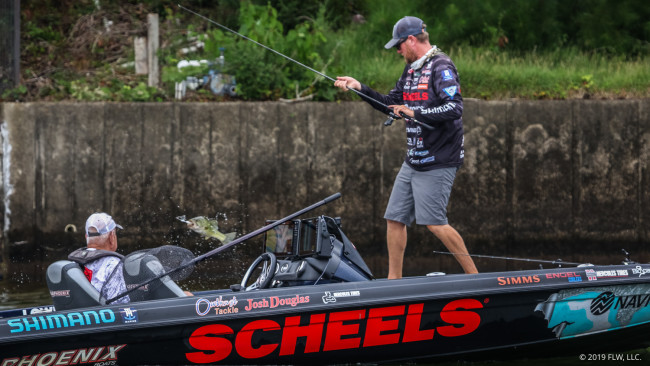Cup Top 10: Douglas Fished Brush and a Buzzbait
Minnesota pro worked the combo program for ninth place at Hamilton

Minnesota pro Josh Douglas is regarded as an electronics expert. But while he put his Lowrance units to the test at the FLW Cup on Lake Hamilton to find offshore brush piles, even Douglas couldn’t resist spending some time in the mornings hunting shallow bass.
“Every morning except today [Sunday] I started up shallow,” Douglas says. “In practice I could catch them easier up shallow on a buzzbait just moving around docks – deeper docks and stuff like that. I never did catch big ones doing that. I could catch limits.”
The shallow pattern was pretty straightforward. With buzzbait in hand, Douglas visited some new water but also re-ran any banks where he got a couple bites. The goal was to capitalize on the low-light period of early morning to ease some of the pressure of a “grinder” of a tournament.

“Once I’d get a limit, or once I felt like the buzzbait bite was dead, I would go out to the brush,” he adds. “That’s where I’d get my big bites. I caught a 7 in practice and a couple 4-pounders. The bites were just so stingy. You just had to hit them at the right time and capitalize on them.
“Most of my good brush piles were 15 to 22 feet. I just idled around the boat ramp area. I spent a lot of time in that area, knowing that there’s a lot of release fish from past tournaments that they’ve had there.”
The brush is where Douglas really earned his top-10 finish.
A lot of his success stemmed from preparation. The Mille Lacs Lake fishing guide spent the entire first day of practice at Hamilton idling for brush piles in the lower end of the lake. He never made a cast that day.
Getting the idling in early freed him up to explore shallow and later dedicate time to figuring out how to get bit in the brush.
Douglas zeroed in on two brush baits. His primary tool was a Texas-rigged blue fleck Zoom Ol’ Monster with a WOO! Tungsten weight and a 5/0 Owner round-bend hook. The other was an Outkast Tackle Goldeneye Swimbait Jighead with a BioSpawn ExoSwimmer swimbait, which he also threw to some schoolers. He occasionally used a drop-shot, too.
“I’d start with the worm to see if I could pull a big one out of there, and then I might try to pick off a spotted bass,” Douglas says. “They’ll sit up on top of it. Those largies sit in it or around it. With the cloud cover, lack of current, whichever one it was, you’d see bigger marks off to the side. But when they get in it they’ll definitely eat.
“There’s fish there always on them,” he adds. “They’re not going anywhere, but they get pressured. They get fished for. So it’s a timing deal, and sometimes you have to make 10 casts at the same brush pile, and all of a sudden, boom.”

Douglas originally thought the brush pile bite was going to be best in sunny conditions, but that’s what the top 10 had on the last day, and most of the brush specialists struggled. Douglas weighed in just four keepers for 5 pounds, 3 ounces on Sunday, compared to limits of 9 and 12 pounds the first two days.
Looking back, he now wonders if the lack of current was the primary factor for the tougher fishing on Sunday.
Regardless, Douglas’ location and approach, which led to a three-day total of 26-3, were good enough for a ninth-place finish in his first FLW Cup.
Webster's seventh-place pattern